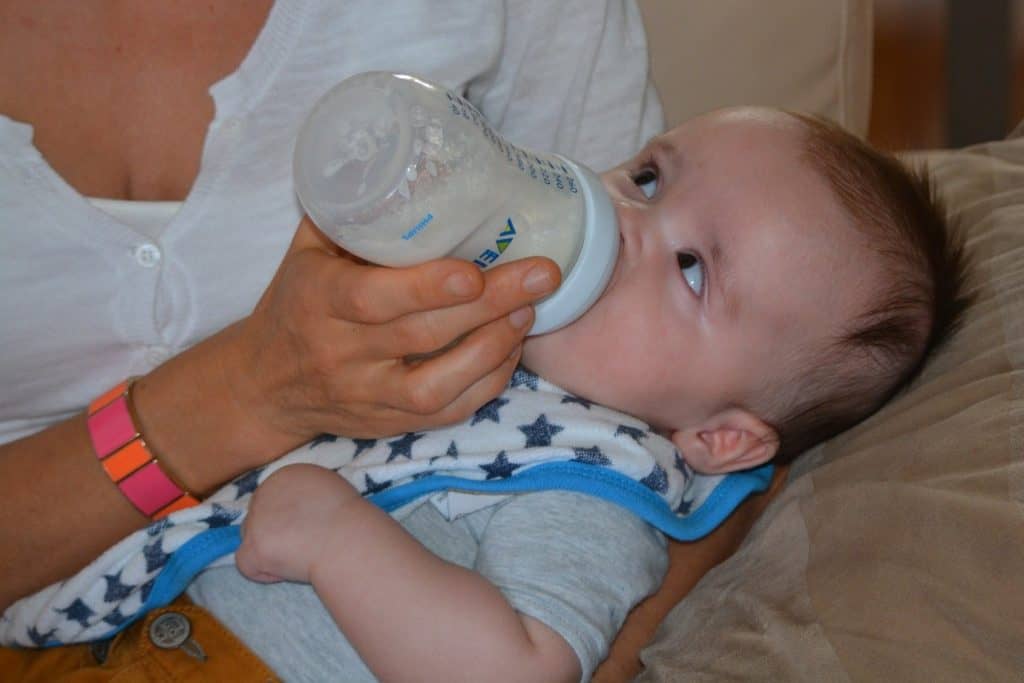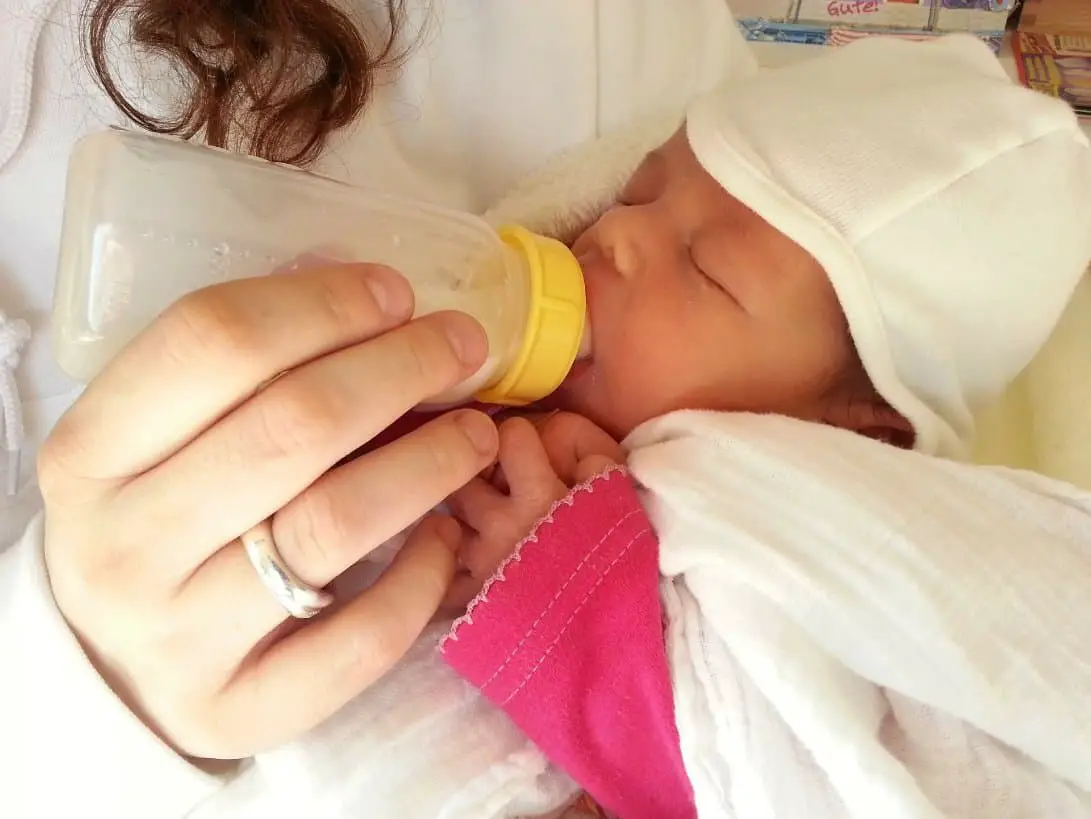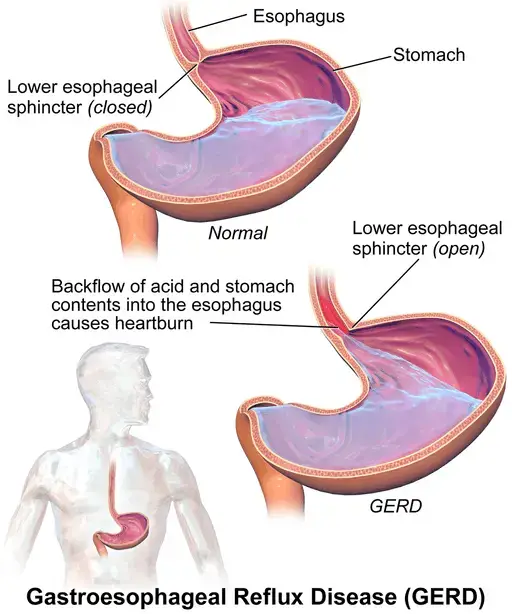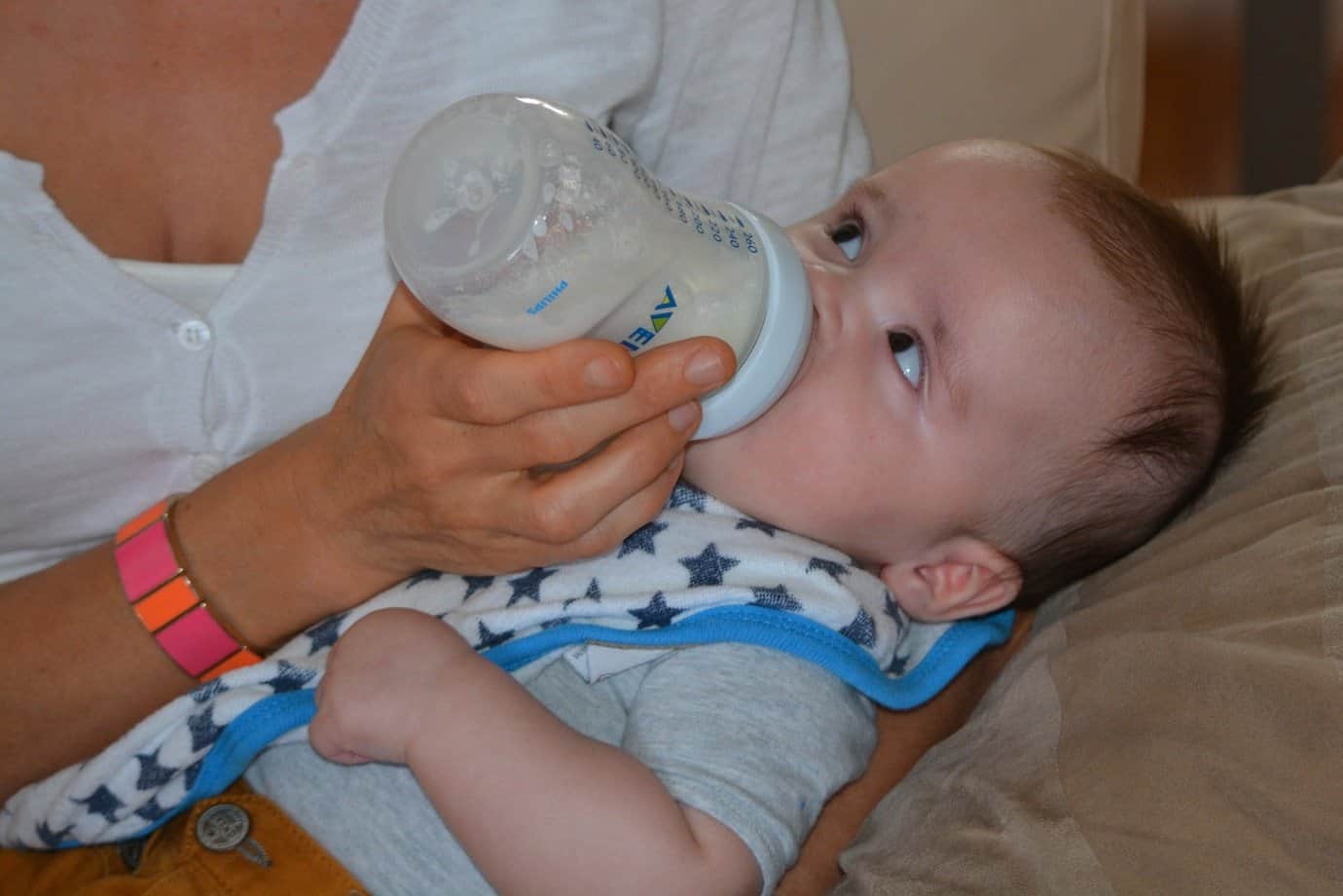Your baby might make gulping sounds when you are feeding her. And you might be wondering why she does that and if you should try to do something about it.
In our opinion, your baby is making gulping sounds when bottle feeding because the milk is coming too fast and she can’t swallow it fast enough. There can be several reasons for this but mainly it’s because the milk flows too fast.

Table of Contents
- How will you know that your baby is gulping?
- What can you do to have a gulp-free feed?
- Does your baby make a clicking noise while feeding?
- What is that smacking sound that my baby makes while feeding?
- My baby makes gulping sounds when not feeding
- My baby is swallowing air while bottle-feeding
- My baby is dribbling milk while feeding
- The baby is choking while bottle-feeding
- Baby is not swallowing milk from the bottle
- Baby drinks bottle too fast?
- Why does baby make swallowing sounds when not eating?
- What kind of bottle and Nipples are good for your baby?
- Conclusion
- READ NEXT
How will you know that your baby is gulping?
Sometimes you can hear your baby gulping down the milk nice and clear, other times it might happen silently.
You will know that your baby is gulping because she will look uncomfortable. She might pull her face and not look peaceful while drinking. Or she might try to swat the bottle away. Another sure sign that she is not enjoying the feeding is when she spreads her fingers apart.
Hey! By the way… any links on this page that lead to products on Amazon are affiliate links and I earn a commission if you make a purchase.
Thanks in advance – I really appreciate it!
What can you do to have a gulp-free feed?
Use a slow flow bottle teat
Buy a Slow Flow nipple to feed your baby. These teats allow the milk to flow slower, which makes it easier for your baby to swallow the right volume of milk. Different brands have different slow flow teats. You will have to try a few out before you find one that works for your baby.
You might want to try the Evenflo Feeding Balance wide neck nipples, designed to provide a gulp-free flow rate.
CLICK ON IMAGE FOR DETAILS
Make sure the nipple engages your baby’s whole mouth
Your baby’s lips need to completely cover the teat. There should be no gap between your baby’s lips and the teat. When there are gaps, your baby will swallow air and will most probably start drinking with gulping sounds.
The bottle nipple should widen where it touches your baby’s lips. Try different bottle nipples to see what works for your baby.
Try feeding in an upright position
This is one of the best breastfeeding positions.
Think about yourself drinking. If you sit upright it’s easy to drink and swallow; if you lie down and drink, the liquid flows too fast for you to swallow.
The same principle applies when feeding your baby.
Try to hold her in a semi-upright position so the milk flows slower and she can drink more comfortably.
READ ALSO : Learn why baby chokes – Why does my baby choke while bottle feeding – 7 reasons
Hold the bottle right
Don’t hold the bottle at a sharp upside-down angle.
Tilt the bottle only enough so the teat is filled with milk.
This trick will help that the milk doesn’t flow too fast and overwhelm your baby.
Don’t let your baby drink without interruption
Let your baby catch her breath for a few seconds while she is feeding.
Again, think of yourself when you drink something – you also take a short breath between swallows, don’t you?
To let your baby rest a while, tilt the bottle so the milk doesn’t flow into her mouth. Let her catch her breath, and continue feeding.
Does your baby make a clicking noise while feeding?

Image by Dirk (Beeki®) Schumacher from Pixabay
If your baby makes a clicking sound while feeding it’s a sure sign that she’s not latching onto the bottle nipple properly.
Latching onto a nipple, whether a bottle nipple or a breast nipple, is not as straightforward as you might think.
For many babies, it’s difficult to latch onto a nipple. There are various reasons for this. For instance, the baby may be premature with a very small mouth.
Your baby must properly latch onto a bottle nipple to get enough milk and thrive. Watch your baby’s mouth and sucking action. If she doesn’t latch onto the teat properly, try another one.
Apart from the clicking sound you hear, your baby will not feed peacefully and might even refuse feeds if she can’t latch properly.
What is that smacking sound that my baby makes while feeding?
That loud smacking noise your baby makes while feeding could be the result of a poor latch-on.
This may be due to a condition called lip tie.
Lip tie makes it very difficult for a baby to latch on and stay latched on.
What is a lip tie?
The piece of flesh behind your upper lip in your mouth is called the frenulum. You can feel it with your tongue. When that piece of flesh is stiff or too thick, it causes lip tie. Lip tie may make it difficult for the baby to move her upper lip, so she can’t control it.
Lip tie isn’t necessarily a big problem, as long as the baby keeps gaining weight.
Lip tie symptoms
You can suspect that your baby suffers from lip tie if your baby
- struggles to latch on to the nipple
- has difficulty breathing during feeding
- makes a clicking sound while nursing
- becomes very tired during feeding
- keeps falling asleep during nursing
- doesn’t gain weight or gains weight slowly
What can you do?
There is a surgical procedure called lip tie revision that can be performed by a pediatrician, but experts advise that parents first consult a pediatrician or a lactation consultant to discuss the issue. The surgery often doesn’t improve the condition.
A lactation consultant can show you how to feed your baby effectively.
Babies with lip tie feed easier from a bottle than the breast.
My baby makes gulping sounds when not feeding
If your baby makes gulping sounds when he’s not feeding it might be caused by acid reflux.
Acid reflux happens when food and acid in your baby’s stomach doesn’t remaiin in the stomach, but come back up into the esophagus.
This is known as Gastroesophageal Reflux disease ( GERD).

The esophagus is the tube that takes food from the mouth to the stomach.
At the lower end of the esophagus is a muscle that tightens to keep food in the stomach. If this muscle doesn’t work properly, the food can come back up in the esophagus and cause your baby great discomfort.
How can you help your baby?
Be careful to put your baby in a position that keeps her body upright and straight. Placing your baby in an upright position will help the food to stay in the stomach.
A slouched position will create pressure on the stomach and the food might be forced back up the esophagus.
If you have to put your baby down after a feed, you can use rolled blankets or towels to keep her body in an upright position.
If you notice symptoms of discomfort during feeding, keep your baby upright and straight after eating. Don’t lie him down straight after feeding.
My baby is swallowing air while bottle-feeding
Many babies swallow air when they are feeding. This happens if
- the baby drinks too fast
- the baby’s mouth doesn’t cover the teat completely
- the baby is lying down while feeding
- the teat holes are too big so the milk flows too fast
- the baby cries intensely for an extended time
When you buy teats for your baby bottles, check that the holes are of such a size that they let one drop of milk drip per second.
Swallowing air can cause painful gas discomfort, but it’s something that can’t be completely avoided.
What can you do?
Burp your baby regularly.
You should burp your baby during and after feeding. Don’t let your baby lie down flat during a feed. Hold her in a seated position while you support her head with your hand. Most parents find it effective to burp their baby over their shoulder. Rub your baby’s back and hold her upright to help her burp.
Do this a few times during a feed and also spend time burping your baby after each feed.
While feeding, tip the bottle so the milk completely fills the bottle nipple. Your baby’s mouth should completely cover the nipple.
Choose a bottle nipple that is soft and fills your baby’s mouth. Be sure to check that the milk doesn’t flow too fast.
You can check the nipples shown below
No products found.CLICK ON IMAGE FOR DETAILS
Be aware of how long your baby takes to feed. If she gulps down her bottle in 5 minutes, she’s drinking too fast and will swallow a lot of air. A typical feed should take about 20 minutes.
My baby is dribbling milk while feeding
It’s easy to see why babies may dribble milk while feeding. When you hold a bottle upside down to feed a baby, the milk flows out due to gravity, even when the baby stops sucking. This means the milk keeps coming even when the baby doesn’t want any more or is tired of sucking.
When this happens, the baby can become stressed. You will notice the stress when your baby
- tries to push the bottle away
- turns her head away from the bottle
- gulps or coughs
- splay her fingers
- has milk running down her mouth
What can you do?
Hold your baby in an upright position and the bottle at a slight angle to control the flow of milk. Make sure the nipple is filled with milk.
When you start a feed, don’t force the nipple into his mouth. First, touch the teat to her mouth to let him get ready for the bottle.
Also, check that your baby’s lips completely cover the teat so there’s no room for air to get into her mouth.
Take note of how often your baby swallows. She should swallow once every two or three times she sucks. When you notice she stops sucking to swallow, tip the teat upwards so the milk stops flowing. This action will stop milk from dribbling from her mouth.
Dysphagia could also be a reason for the baby dribbling while bottle feeding.
Common dysphagia is a medical term for a swallowing disorder.
The baby is choking while bottle-feeding

Nathan Dumlao via Unsplash.com
One of the most common causes of babies choking on their milk while bottle feeding is prop feeding or bottle propping.
This happens when the baby is not held by an adult while feeding. The baby is put down and her bottle is propped up against a pillow or rolled-up blanket or towel to keep it upright.
This is very dangerous and can cause the baby to choke. Think about it, due to gravity, the milk just keeps on coming regardless of whether your baby is ready to swallow it or not. There is no one to notice that the baby’s mouth is getting too full and the milk is running from her mouth.
The thing is, a baby choking doesn’t always make a sound, so you won’t necessarily realize that your baby is busy choking.
If you leave your baby alone with a propped-up bottle, you are putting him at great risk.
Baby is not swallowing milk from the bottle
When your baby won’t take a bottle, it may be that you introduced your baby to the bottle too late.
Most babies who don’t take to the bottle easily are used to the breast and find it difficult to adjust to feeding with a bottle.
This is called Paced bottle feeding.
When they are born, babies have an automatic sucking reflex, but two or three months into their lives they have developed a sucking action that is adjusted to getting milk from the breast and mother’s nipple.
It may be difficult for a baby to adjust from the breast to the bottle as the milk flow from a bottle is different and so is the nipple. The texture, shape, and feeling of the nipples differ considerably.
All these factors may account for your baby’s refusal to drink milk from a bottle.
What can you do?
If you want your baby to feed from a bottle you mustn’t breastfeed too long. But you also don’t want your baby to miss out on the benefits of breastmilk. So your baby should breastfeed for at least the first four weeks before you introduce the bottle.
Most babies will adjust to the bottle at around four weeks.
You can begin the process by initially switching back and forth between breastfeeding and the bottle. This way your baby will gradually get used to the bottle.
Another trick you can try is to offer the bottle immediately when your baby has woken up after a nap. When the baby has just woken up she is not distracted and will focus on feeding.
Also, don’t let your baby get too hungry. If she is too hungry, she will already be upset and not in the mood to try something unfamiliar.
Baby drinks bottle too fast?
Your baby might also be drinking too quickly because he wants more than what he needs.
It could be that he isn’t taking enough time between each sip. He’ll need to learn this skill as well.
How to slow my baby down when bottle feeding?
You can help teach your baby to slow down by holding the bottle still until he finishes sipping before offering another.
He’ll soon figure out that if he takes longer to finish off the first bit then he gets more to eat.
Why does baby make swallowing sounds when not eating?
If your baby is making swallowing sounds when not eating or when sleeping then your baby has silent acid reflux symptoms.
She swallows the food back down after it comes up into her throat. With this condition the stomach acid can damage the lining of the esophagus.
What kind of bottle and Nipples are good for your baby?
Choosing the right bottle and nipple for your baby can be daunting given the many options available. Ask for recommendations from friends , go through product reviews, and do proper research but be prepared for trial and error, as that is the best way to find out
You can find the right bottle-nipple combination by learning about your little one’s preferences. Some babies are not too choosy and can make do with any bottle and nipple while some prefer a particular nipple shape or bottle brand.
✅ Here are some top selling bottles and nipples which are popular with young mothers.
Since you have no control over your baby’s likes, just accept it calmly , and be ready to try out different options before you arrive at a proper selection. If you need help in what key points to consider to help yo pick the best bottle/ nipple for your baby , you can read this article.
Conclusion
Babies make many different sounds while feeding. These sounds are usually an indication of some or another feeding problem. These feeding problems are not serious and a few simple tricks can resolve them.
You know you are doing things right when your baby appears relaxed while feeding.
If she shows signs of not enjoying her feed, try the advice we offered in this post. You will find it will help a lot.
READ NEXT
15 Proven Signs Your Baby Will Have Beautiful Curly Hair That You Love
If you’ve ever wondered if your baby will have curly hair, there are signs to…
How to wash baby hair without getting water in the eyes
Babies are sensitive to eye infections and they can cause serious problems in the future….
Top 7 Best Baby Hair Oils for Babies |2022
Baby hair oil is a very important product for babies. It is an essential part…
Coconut Oil for Babies Hair – An Essential Guide
What is Coconut Oil? Coconut oil is a natural hair care product that is used…
9 Best Curly Hair Products for Babies in 2024
If your baby has curly hair, I don’t need to tell you how hard its…
Can a Baby’s Hair Change from Straight to Curly?
One of the common questions that I see in natural hair forums include ‘how come…









